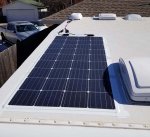montypower
Adventure Time!
Everyone has advice and tips for how much solar power (watts) you need. I’ve found there is the theoretical, mathematical formula and the real world practical aspect.
There are many factors to consider:
1. Solar only. Will you have any other power source? Generator, alternator, shore power…
2. Seasonal travel. You can make do with much less solar if primarily traveling in the summer months. However, you will benefit from doubling the solar power for use in adverse weather and winter.
3. Parking location & tipping panels. Are you willing to always park in the sun vs shade? Will you move your solar panels and tip them to follow the sun?
You’ll want to go “overkill” if you plan to have a solar powered rv, van or camper and never “think” about it. What this means is you’ll want to take the adequate amount of solar needed during “summer” months and double it. This will allow for you to not worry about tipping your solar panels and chasing the sun. It will also be functional on cloudy, rainy and winter months.
Yes, the amount of power you use is an important factor. But just as important is when and where you use your truck camper.
Overall, I’d install absolutely as much solar as physically possible. 600+ watts of solar is a good base number for year round functionality. We are running 800watts and that has worked well this year in all conditions. We only had a couple times where the DC charger was required (once when the roof was covered in snow).
How much solar do you use?

